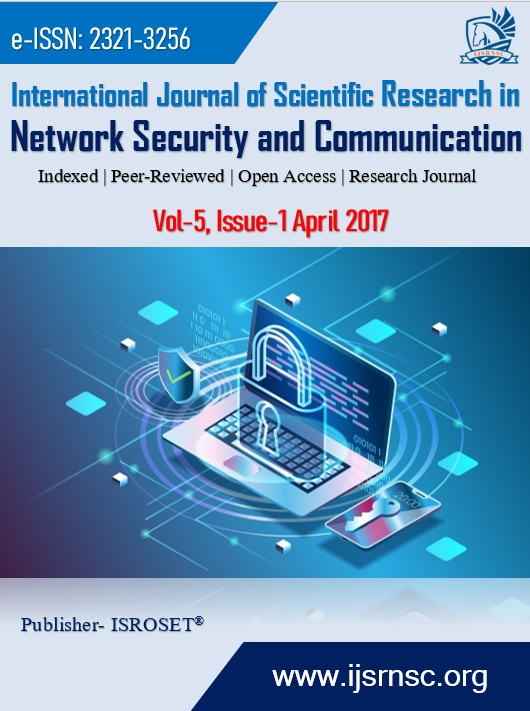An Efficient PAPR Reduction Technique for OFDM
Keywords:
PAPR, RF, OFDM, SE, EEAbstract
This Orthogonal Frequency Division Multiplexing (OFDM) is an efficient multiplexing & a bandwidth efficient modulation scheme in wireless communications.However, OFDM faces the high Peak-to Average Power Ratio (PAPR) problem that is a major drawback of this multicarrier system which leads to power inefficiency in the RF section of the transmitter.Thus, the OFDM signals with high PAPR could seriously be distorted by the non-linearity of the HPA, resulting in degradation of both spectral efficiency (SE) and energy efficiency (EE) performances. Our paper will review a few techniques to reduce the high PAPR to combat multipath fading and signal distortion which will facilitate better data transmission.
References
S. Kunal, N. Mohan, G. Kavita, K. Monali, D. Pooja, “Improving throughput in Wireless LAN using Load Balancing Approach”, International Journal of Computer Sciences and Engineering, Vol.2, Issue.4, pp.38-43, 2014.
F. Schaich and T. Wild, “Waveform contenders for 5G — OFDM vs. FBMC vs. UFMC”, 2014 6th International Symposium on Communications, Control and Signal Processing (ISCCSP), Athens, pp. 457-460, 2014.
Mamta Bisht and Alok Joshi, “Various Techniques to Reduce PAPR in OFDM Systems: A Survey”, International Journal of Signal Processing, Image Processing and Pattern Recognition, Vol.8., No.11, pp.105-208,2015.
Parneet Kaur, Ravinder Singh, “Complementary Cumulative Distribution Function for Performance Analysis of OFDM Signals”, IOSR Journal of Electronics and Communication Engineering (IOSRJECE), Vol.2. Issue.5, pp.5-7, 2012.
Pawan Sharma, Seema Verma, “PAPR Reduction of OFDM Signals using Selective Mapping with Turbo Codes”, Intnl.Jrnl. of Wireless and Mobile Networks, vol.3, no.4, pp.12-19, 2011.
Chinkalkumar B. Patel, “A New SLM Scheme with Clipping for PAPR Reduction in OFDM Systems”, Intnl. Jrnl. for Scientific Research and Development, Vol.3, Issue.2, pp.154-161, 2015.
Ibrahim Abdullah, “Comparative Study of PAPR Reduction Techniques in OFDM”, ARPN Jrnl. Of Systems and Software, vol.1, no.8, pp.11-16, 2011.
Kavita Mhatre, UP Khot, “Efficient Selective Mapping PAPR Reduction Technique”, Intnl. Conference on Advanced Computing Technology and Applications, India, pp.620-627, 2015
Kishore Kumar, RR Nagaralli, “Introduction to SLM and Clipping Techniques and its Comparative Analysis to Reduce PAPR in OFDM Systems”, Intnl. Jrnl. Of Electrical and Computer Engineering, vol.1, issue 4, pp.321-327, 2015.
Maan Singh, Vijay Kumar, “Signal Scrambling Techniques for PAPR Reduction in OFDM Systems”, International Journal of Engineering and Computer Science, vol.2, issue 1, pp.311-317, 2013.
N.R. Raajan, S. Prabha, D. Meenakshi, “Improved Performance in OFDM Systemsby PAPR Reduction Techniques”, International Conference on Computer Communication and Informatics, India, pp.1-4, 2013.
Suverna Sengar, PP. Bhattacharya, “Performance Improvement in OFDM Systems by PAPR Reduction”, Intnl. Jrnl. Of Signal and Image Processing, vol.3, no.2, pp.1-9, 2012.
Lingyin Wang, Ju Liu, Wenbo Wan and Jingkai Liu, “Scrambling scheme based on information hiding for PAPR reduction of OFDM signals with PSK inputs”, 2011 IEEE 13th International Conference on Communication Technology, Jinan, pp.462-465, 2011.
Y. C. Wang and Z. Q. Luo, “Optimized Iterative Clipping and Filtering for PAPR Reduction of OFDM Signals,” in IEEE Transactions on Communications, vol. 59, no. 1, pp. 33-37, January 2011
Dov Wulich, “Definition of Efficient PAPR in OFDM”, IEEE Signal Communication Letters, Vol.9, No.9, pp.8320834, 2005.
S. Singh, A.S. Buttar, “Carrier Frequency Offset Estimation Techniques in OFDM System: A Survey”, International Journal of Computer Sciences and Engineering, Vol.2, Issue.8, pp.74-77, 2014.
NV. Jadhav, SC. Panchal, MR. Rotti, “Client Server Network Management System for WLAN (Wi-Fi) with Remote Monitoring”, International Journal of Scientific Research in Network Security and Communication, Vol.1, Issue.1, pp.22-25, 2013.
Downloads
Published
How to Cite
Issue
Section
License

This work is licensed under a Creative Commons Attribution 4.0 International License.
Authors contributing to this journal agree to publish their articles under the Creative Commons Attribution 4.0 International License, allowing third parties to share their work (copy, distribute, transmit) and to adapt it, under the condition that the authors are given credit and that in the event of reuse or distribution, the terms of this license are made clear.









